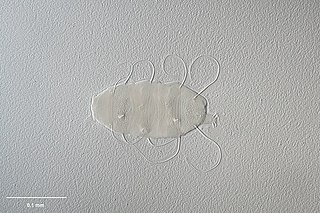
Megatheriidae is a family of extinct ground sloths that lived from approximately 23 mya—11,000 years ago.

The northern or sandy nail-tail wallaby is a species of macropod found across northern Australia on arid and sparsely wooded plains. The largest species of the genus Onychogalea, it is a solitary and nocturnal herbivorous browser that selects its food from a wide variety of grasses and succulent plant material. Distinguished by a slender and long-limbed form that resembles the typical and well known kangaroos, although their standing height is shorter, around half of one metre, and their weight is less than nine kilograms. As with some medium to large kangaroo species, such as Osphranter rufus, they have an unusual pentapedal motion at slow speeds by stiffening the tail for a fifth limb. When fleeing a disturbance, they hop rapidly with the tail curled back and repeatedly utter the sound "wuluhwuluh". Their exceptionally long tail has a broad fingernail-like protuberance beneath a dark crest of hair at its end, a peculiarity of the genus that is much broader than the other species. The name unguifera, meaning claw, is a reference to this extraordinary attribute, the purpose of which is unknown.

Jaekelopterus is a genus of predatory eurypterid, a group of extinct aquatic arthropods. Fossils of Jaekelopterus have been discovered in deposits of Early Devonian age, from the Pragian and Emsian stages. There are two known species: the type species J. rhenaniae from brackish to fresh water strata in the Rhineland, and J. howelli from estuarine strata in Wyoming. The generic name combines the name of German paleontologist Otto Jaekel, who described the type species, and the Greek word πτερόν (pteron) meaning "wing".

Onychopterella is a genus of predatory eurypterid, an extinct group of aquatic arthropods. Fossils of Onychopterella have been discovered in deposits from the Late Ordovician to the Late Silurian. The genus contains three species: O. kokomoensis, the type species, from the Early Pridoli epoch of Indiana; O. pumilus, from the Early Llandovery epoch of Illinois, both from the United States; and O. augusti, from the Late Hirnantian to Early Rhuddanian stages of South Africa.

Echiniscus testudo is a cosmopolitan species of tardigrade.

Hypsibius is a genus of tardigrades in the class Eutardigrada.

Milnesium is a genus of tardigrades. It is rather common, being found in a wide variety of habitats across the world. It has a fossil record extending back to the Cretaceous, the oldest species found so far is known from Turonian stage deposits on the east coast of the United States. Milnesiums are one of the most desiccation and radiation-resistant invertebrates on Earth because of their unique ability to transform into a "tun" state and utilize intrinsically disordered proteins when experiencing extreme environments.

Echiniscoidea is an order of tardigrades, a phylum of water-dwelling, eight-legged, segmented micro-animals. It was first described by Richters in 1926.

Echiniscus is a genus of tardigrades in the family Echiniscidae. The genus was named and described by Karl August Sigismund Schultze in 1840.
Batillipes is genus of tardigrades, the only genus in the family Batillipedidae. It was first described by Ferdinand Richters in 1909.
Pseudechiniscus is a genus of tardigrades in the family Echiniscidae. The genus was named and described by Gustav Thulin in 1911.
Cornechiniscus is a genus of tardigrades in the family Echiniscidae. It was named and described by Walter Maucci and Giuseppe Ramazzotti in 1981.

Antechiniscus is a genus of tardigrade in the family Echiniscidae. The genus was first described by Reinhardt Kristensen in 1987.
Neoarctus primigenius is a species of tardigrade. It is the only species in the genus Neoarctus, which is the only genus in the family Neoarctidae. The genus and species were first described and named by Grimaldi de Zio, D'Addabbo Gallo and Morone De Lucia in 1992. The authors first placed the genus in the family Stygarctidae, but it was moved to a separate family in 1998.
Bryochoerus intermedius is a species of tardigrade of the family Echiniscidae. It is one of two species of the genus Bryochoerus. The species was first described by James Murray in 1910 as Echiniscus intermedius.
Anisonyches is a genus of tardigrades in the family Echiniscoididae. The genus was first described and named by Leland W. Pollock in 1975. The genus name is a combination of the Greek aniso ("unequal") and onyches ("claws"), since Anisonyches have four claws each on the first three pairs of legs and three claws each on the fourth pair of legs.
Bathyechiniscus tetronyx is a species of tardigrades. It is the only species of the genus Bathyechiniscus, which belongs to the family Styraconyxidae. The species and genus were named by Gotthold Steiner in 1926, for the presence of four different exposed points or hooks on each claw. The species has been found in the Davis Sea, on the eastern coast of Antarctica.
Trogloarctus trionyches is a species of tardigrade. It is the only species in the genus Trogloarctus, which is part of the family Coronarctidae. The species are found in the Mediterranean Sea. They were first found in 1996 in an underwater cave near La Ciotat in the Bouches-du-Rhône department, southern France.
Mesobiotus is a genus of tardigrades belonging to the family Macrobiotidae.









